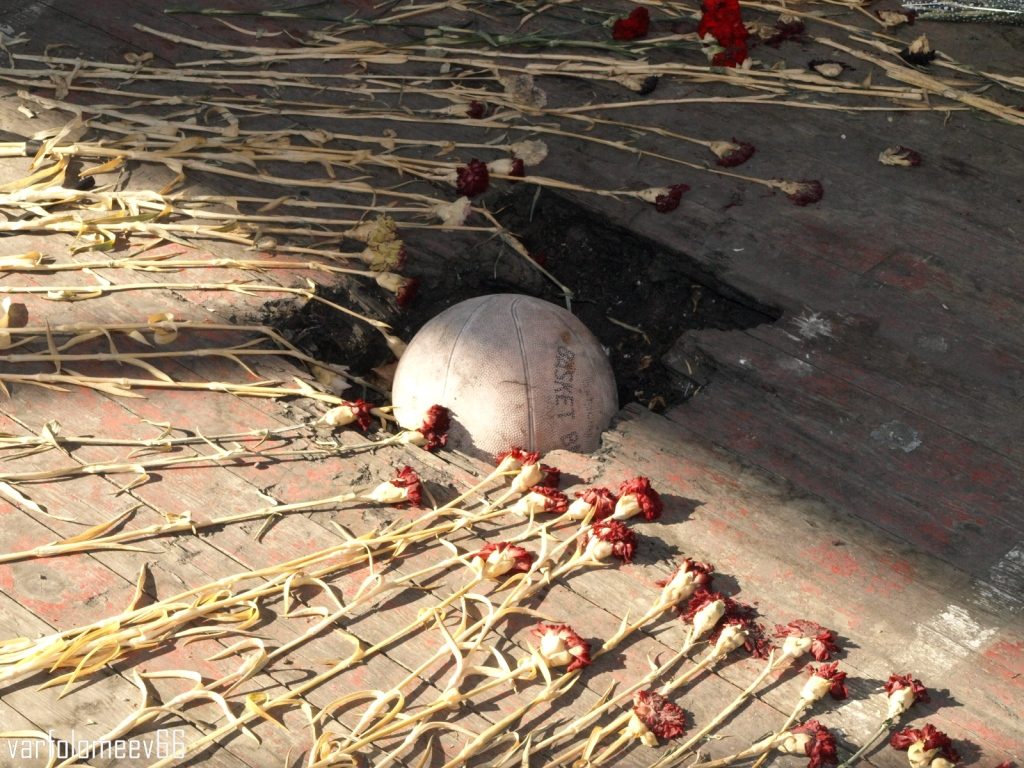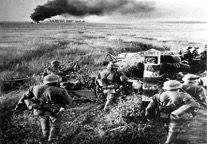For students all around Russia, September 1 traditionally marks the end of a fun-filled summer and the start of a new school year. On this day, their families and educators join them to celebrate what is known in Russia as the “Day of Knowledge.” For many schools, the year 2004 would be no different. Students would pick out flowers for their teachers and parents would prepare their children for the ceremony.1 This wouldn’t be the case for the Beslan School Number One, however. Their festivities would be interrupted by an evil force that would change the Beslan community forever.
Students ranging from the ages of seven to eighteen, along with teachers and staff, filled their school building. Parents and families were also present, anticipating the celebration of the national holiday. At 9:30 am, just before they were about to begin, around 32 armed terrorists entered the school and forced over 1,000 people into the school’s gymnasium. The terrorists wore camouflage uniforms and ski masks. Two of them were women, and many of them had explosives attached to their belts.2
Earlier that morning, in a forest northeast of Beslan, the group began preparing for the terror they were about to bring to the Beslan community. Led by Ruslan Khuchbarov, the Chechen and Ingush members took the less-populated roads to Beslan. They were pulled over by a policeman on the way, whom they held at gunpoint and overtook his vehicle, holding him hostage in the back seat. Once they arrived at the school, the policeman took off and ran to the police station, while the terrorists began to fire their weapons in the air.3
The motives behind the attack stem from a historically troubled relationship between Russia and Chechnya. In the early nineteenth century, Russia forcibly annexed the Chechen ethnic group into the Russian empire, but they resisted Russian rule for over a century. In 1917, Chechnya declared its independence, but was put down in 1920 by the Red Army. Once the Soviet Union collapsed in 1991, Chechnya was led by Dzhokar Dudayev, a former Soviet bomber pilot that declared independence for Chechnya from the Russian Federation. Russia refused, once again, to accept Chechnya’s independence and started two Chechnya wars that would happen in the next decade. Although Russia put an end to Dudayev’s rule, the capital city of Grozny and its people fell victim to the warfare. In the now pro-Russian government Chechnya, Chechen rebels emerged in 1996 and have been carrying out terrorist attacks ever since. Russia’s response to those attacks have included heavy military antics, resulting in even more civilian casualties.4
The conditions for the people in the gymnasium were unbearable. It was overcrowded, the people were denied food and water, and they weren’t allowed to use the facilities. Two fathers had been executed in front of the rest of the hostages and their children for disobeying the terrorists’ orders. To make matters even worse, the terrorists placed explosives on the gym walls and in bottles hanging over the children’s heads. They had even set up an explosive known as “Dead Man’s Switch,” that would be detonated if one the terrorist standing on it stepped off. There was no end in sight for the hostages at this point, the terrorists made sure of that. They strengthened their position by placing trip wires around the building to prevent rescue operations.5

Outside of the school local police, army troops, and worried families gathered, watching the terrorists’ every move. They were unsure of what actions to take considering the strength of the terrorists’ position and the lack of direction from the Russian government. In the year before, on October 24, 2002, 53 Chechen rebels had seized the Moscow Dubrovka Theatre, holding 979 hostages. Russia’s military response was to release a gas that would make the terrorists unconscious along with the hostages, making it a more feasible rescue. However, 128 of those hostages died during the rescue. The Russian government received a lot of criticism for their heavy military tactic in response to the crisis.6 Consequently, this would result in an even greater hesitation to take action against the terrorists inside the Beslan School.
The terrorists requested Ruslan Aushev, the former president of neighboring Ingushetia, to be the negotiator between the two sides. Aushev also had a role in the negotiations during the Moscow Hostage Crisis in 2002. However, he was not successful in the negotiations, although the terrorists did agree to release 26 mothers and infants. Some of the mothers refused to leave their older children behind in the gym and stayed with them. In the third and last day of the siege, around 1:00 in the afternoon, a medical team approached the school to remove the bodies of those that had been killed so far, as permitted by the terrorist group. As the team began to reach the building, the terrorists began to fire at them, killing two medical workers. An explosive was then detonated, causing parts of the gym’s ceiling to collapse. Hostages began to make a run for it, getting caught in the crossfire between the terrorists and the Russian special forces, army troops, armed civilians and police on the other side of the school yard. A tank and helicopter gunships were also present in the assault, which lasted for about two hours. During these two hours, more bombs went off, leaving the school building in flames, and terrorists attempted to escape as the Russian forces took over the school. At the end of the assault, 344 civilians had died, at least 172 of them were children. Some were missing or unidentifiable due to being consumed by fire. Only one terrorist was left alive.7

Once again, the Russian government received criticism for its response to this terrorist attack–starting with the lack of protection in schools in this region after being tipped off about a preemptive attack before the siege, to the lack of medical teams on the scene, leaving civilians responsible for driving the victims to the unequipped local hospital. Another criticism involved the authority’s dictation over the media coverage of the siege. Only the Russian authority’s and officials’ perspectives were reported during the crisis, making it seem as if the Russian government was being “resourceful and effective” when responding to the crisis. However, the few eyewitness reports that exist say otherwise.8 Not only did this alter the narrative surrounding the crisis, but at the beginning of the siege, terrorists were outraged by the authority’s control of the media coverage. The portrayal of the crisis was construed to look as if the Russian government had everything under control, when in reality and unfortunately, the terrorists had a greater force and control of the negotiations and hostages. This prompted them to throw the bodies of the executed men out of the window.9 Another failure that was also pointed out on behalf of the Russian government’s handling of the crisis was that investigators failed to examine the evidence left on the site before allowing bulldozers and other heavy machines to take the remaining debris.10

Although the Russian Parliamentary commission exonerated Russian security forces by placing the blame for the high death toll solely on the Chechen terrorists, the issue of Russia’s response to both the Beslan and Moscow Theatre Crisis remains in conversations today.11 Russia has since implemented some changes after the occurrence of these attacks. Following the Beslan attack, they reinstated the death penalty for terrorism. However, this measure hasn’t completely stopped terrorist attacks from Chechen and Ingush insurgents. Furthermore, in 2013, threats from Islamist militants grew as they began funding and aiding Chechen separatists.12
For weeks following the Beslan School Number One siege, several memorials and burials took place. Families mourned their loved ones. Teachers mourned their students. While the rest of the world continues to celebrate Day of Knowledge each year, Beslan remembers the great loss of innocence in its community during those three days that began with the interruption of their celebration.
- Olga Gorshkova, “Russia celebrates ‘Day of Knowledge’,” Russia Beyond (website), May 9, 2019, https://www.rbth.com/articles/2012/08/01/russia_celebrates_day_of_knowledge_holiday_17823.html. ↵
- Sergey Ponomarev, and NTV-Russian Television Channel, Beslan School Massacre, 2006 (Terrorism: Essential Primary Sources), 175-78. ↵
- Timothy Phillips, Beslan: The Tragedy of School No. 1 (Great Britain: Granta Books, 2014), 18-23. ↵
- Society for Russian-Chechen Friendship, Russia-Chechnya Conflict, 2006 (Terrorism: Essential Primary Sources), edited by K. Lee Lerner and Brenda Wilmoth Lerner, 169-72. ↵
- Sergey Ponomarev, and NTV-Russian Television Channel, Beslan School Massacre, 2006 (Terrorism: Essential Primary Sources), 176. ↵
- Aglaya Snetkov, “The Image of the Terrorist Threat in the Official Russian Press: The Moscow Theatre Crisis (2002) and the Beslan Hostage Crisis (2004),” Europe-Asia Studies 59, no 8 (2007): 1352. ↵
- Sergey Ponomarev, and NTV-Russian Television Channel, Beslan School Massacre, 2006 (Terrorism: Essential Primary Sources), 176. ↵
- Sue-Ann Harding, “Translation and the Circulation of Competing Narratives from the Wars in Chechnya: A Case Study from the 2004 Beslan Hostage Disaster,” Les Presses de l’Université de Montréal, (March 2011): 46-47. ↵
- European Court of Human Rights, Case of Tagayeva and Others v. Russia, April 13, 2017: 14. ↵
- European Court of Human Rights, Case of Tagayeva and Others v. Russia, April 13, 2017: 17. ↵
- C.J. Chivers, “Russian Excuses Itself in Final Report on Beslan,” The New York Times, 2006. ↵
- Joshua Sinai, “Terrorist Threats Against Russia and Its Counterterrorism Response Measure,” Connections 14, no. 4 (2015): 97-98. ↵



26 comments
Donte Joseph
I had never heard of this story, but it is heartbreaking to know that some things never change. This took place in 2002, and even in modern times we are still having to deal with school shootings and terror attacks. The fact that all of this came from people wanting to send a message is just wrong and should not be taken lightly. Russia definitely should have been more proactive and I hope that something like this does not continue to happen because innocent lives should not be taken just to send a message.
Maria Obregon
This article was very informative. I had never heard about this terrorist attack until now and it is extremely heartbreaking that young students had to face the consequences of a historically troubled relationship between Russia and Chechnya. It is also upsetting how the Russian government was not doing any effective work after this. While that is the case though, it does not surprise me. Overall, this was a great article. I also liked how it had the two point of views.
Tavion Varela
I had never heard of this story prior to reading it but it was well-written and presented. The beginning setting to the story really makes you empathize with the victims even more because they were just getting ready for their daily lives. Even though it was a terrible act that the terrorists carried out, it was interesting to hear from their view points. It gives you a dive into why they did what they did and gives the article a complete coverage of the story.
Aleea Costilla
I had never heard of this horrendous event that took place and killed hundreds of civilians. In many ways, this article relates to the United States and the difficulties that occur within the government to react to situations of such magnitude correctly. Unfortunately, here, a considerable number of people lost their lives due to political conflict by bombers. As an outcome, the Russian Parliamentary has learned to react and can prevent potential tragedies in the future.
Shriji Lalji
It is is a tragedy that so many children had to get hurt in this conflict between Russia and Chechnya. I was shocked the terrorist attack upon the school lasted three days. Russia has a history of swaying the media in their favor like they did during Chernobyl. However Russia clearly does not hold their people to the highest priority. Incidents like these are just sad.
Genesis Vera
This story was very well written. I really enjoyed how a picture was painted throughout the story. I had never heard of this story and the way the description was made at the beginning only made me empathize with the victims more. I also admired how this article did not just speak on the Russian and victims’ points of view on things but also the terrorists. Although, what the terrorist did was wrong and plain evil- we do get a description of “why” they did what they did. This article gave me a complete view of the story and I thought it was a smart decision.
Micheala Whitfield
I enjoy the details in this story. I like the way the story is created in a way that helps you understand the hurt and the conflict of this massacre. This act was specific though. These individuals curated this attack on their revenge on the Russian government themselves. They did it to make a statement and that’s exactly what they did. It’s sad to see civilians and innocent lives being the center of issues that doesn’t involve them.
Amanda Shoemaker
We all tend to be stuck in our social bubbles and don’t hear about things that go on around the world, like this. I had never heard of this tragedy before. This article is very informative and really gave insight into the problems that Russia has had over the last couple of decades. The calculated attack that was held on a bunch of terrified students and parents is horrifying to think of. The government causing things to be worse was just the cherry on top for how horrific this entire event was.
Analisa Cervantes
When I hear of school shootings they are usually in the US and not terrorist associated. Hearing that a group of terrorists went after innocents still disturbs me even though that, unfortunately, seems to almost be commonplace now. It angers me that the Russian response was so ineffective that it increased the casualties and how their government tried to portray that they had everything under control even though that it was clearly not the case.
Kimberly Parker
I’ve never been one to be fond of watching the news, not because I found it boring, but because I didn’t like hearing about how messed up our world was. Reading this article about an event that took place in 2002, is heartbreaking. By the end of the terrorist attack, 344 civilians had died, and at least 172 of them were children. 172 innocent children died, just because 32 armed terrorists decided to enter the school with explosives attached to their belts. It makes me sick that people are capable of such horror.